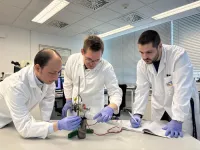(Press-News.org) PULLMAN, Wash. — Wealth inequality began shaping human societies more than 10,000 years ago, long before the rise of ancient empires or the invention of writing.
That’s according to a new study led by Washington State University archaeologist Tim Kohler that challenges traditional views that disparities in wealth emerged suddenly with large civilizations like Egypt or Mesopotamia. The research is part of a special issue of the Proceedings of the National Academy of Sciences, co-edited by Kohler and Amy Bogaard, an archaeologist at Oxford University in England.
Drawing on data from over 47,000 residential structures across 1,100 archaeological sites worldwide, the researchers used house sizes as a measure of wealth. Their analysis shows that wealth inequality started to increase roughly 1,500 years after the advent of agriculture in different civilizations across the world. This effect was driven by population growth, competition for land and the development of hierarchical settlements.
“Many people imagine early societies as egalitarian, but our research shows wealth inequality took root surprisingly early,” said Kohler. “The shift wasn’t instantaneous. It grew gradually as societies expanded, populations increased and resources became more constrained.”
The study highlights several key factors contributing to inequality. As farming communities grew, land became a finite resource, leading to competition and innovations like terracing and irrigation to boost productivity. Over time, larger settlements emerged as hubs of economic and political activity, where wealth began to concentrate in the hands of a few households. These wealth disparities were particularly evident in high population settlements, which exhibited greater inequality than smaller communities.
Tim Kohler
One of the study’s significant revelations is that wealth inequality predates written records, with evidence showing disparities existed even in the earliest agricultural societies. By applying the Gini coefficient—a standard measure of inequality—to ancient house sizes, researchers discovered that early farming villages were relatively egalitarian. However, as settlements became larger and more complex, economic disparities grew.
The study also challenges the idea that preindustrial societies lived in a “Malthusian world” of subsistence-level existence. Instead, Kohler and his team found evidence of steady wealth accumulation and technological advancements over millennia. The researchers point out that early agricultural societies often modified their landscapes—building terraces, draining wetlands, or creating irrigation systems—to intensify production. These innovations increased productivity but also widened the gap between those who controlled resources and those who did not.
Interestingly, the research revealed that some innovations, like iron smelting, often reduced inequality by increasing access to tools and resources for lower social strata. This finding challenges the assumption that technological advances always benefit elites. Kohler also noted that other factors, like the presence of large governing systems or collaborative social networks, played a role in mitigating or amplifying inequality over time.
“This isn’t just a modern problem,” Kohler said. “Understanding the origins of wealth inequality helps us see it as a persistent challenge that societies have been grappling with for thousands of years. The past has much to teach us about navigating these issues today.”
The study was a collaborative effort involving 27 researchers from institutions worldwide and was coordinated by the Coalition for Archaeological Synthesis, a not-for-profit organization dedicated to synthesizing the archaeological record to advance science and benefit society. By focusing on the period before written records, the researchers hope to fill a critical gap in understanding how human societies evolved, from egalitarian hunter-gatherer groups to complex, hierarchical communities.
“These patterns are deeply embedded in our history,” Kohler said. “But by studying them, we can better address their implications for the future. If we can understand how inequality emerged and evolved, perhaps we can learn how to mitigate its impact today.”
END
New study reveals wealth inequality’s deep roots in human prehistory
2025-04-14
ELSE PRESS RELEASES FROM THIS DATE:
New archaeological database reveals links between housing and inequality in ancient world
2025-04-14
If the archaeological record has been correctly interpreted, stone alignments in Tanzania’s Olduvai Gorge are remnants of shelters built 1.7 million years ago by Homo habilis, an extinct species representing one of the earliest branches of humanity’s family tree.
Archaeological evidence that is unambiguously housing dates to more than 20,000 years ago—a time when large swaths of North America, Europe and Asia were covered in ice and humans had only recently begun living in settlements.
Between that time and the dawn of industrialization, the archaeological record is rich not only with evidence of settled life represented by housing, but also with evidence ...
New, non-toxic synthesis method for “miracle material” MXene
2025-04-14
It is one of the most significant trends in materials science: materials that consist of only a single layer of atoms, so-called “2D materials”, often show completely different properties than thicker layers consisting of the same atoms. This field of research began with the Nobel Prize-winning material graphene. Now, research is being conducted into the material class of MXenes (pronounced Maxenes), which consist mainly of titanium and carbon, by TU Wien (Vienna) together with the companies CEST and AC2T.
These MXenes have properties that ...
Cutting-edge optical genome mapping technology shows promise for diagnosis, prognosis, and therapeutic options of multiple myeloma
2025-04-14
Philadelphia, April 14, 2025 – Researchers have demonstrated the potential of the innovative optical genome mapping (OGM) technique for the diagnosis, prognosis, and therapeutic management of multiple myeloma. This new study in The Journal of Molecular Diagnostics, published by Elsevier, details how this novel method can establish the cytogenomic profile of the tumor on a scale suitable for routine practice in cytogenetics laboratories.
Multiple myeloma, a type of blood cancer that forms in plasma cells (a type of white blood cells), is the second ...
Study looks at impact of COVID-19 pandemic on rates of congenital heart disease procedures among children
2025-04-14
Major reallocation of healthcare services during the COVID-19 pandemic meant that elective surgery in children with congenital heart disease (CHD) was significantly reduced, so that those needing urgent, lifesaving and emergency surgery could be treated. However, this prioritisation of the most severely ill children did not increase overall post-operative complications rates or death, a study led by the University of Bristol has shown.
The research, published in Open Heart, suggests that prioritising surgery for younger and more critically ill children may be appropriate when there is a sudden disruption of usual care. The ...
UH researcher unveils new model to evaluate impact of extreme events and natural hazards
2025-04-14
When you’re on a sandy beach or the banks of a river, transformed by rolling waves or slightly still waters, it’s likely you’re not thinking about what happens just beneath the surface, where dirt and pollution are swirling and traveling through to new destinations.
But Hanadi Rifai does. The Moores Professor of Civil and Environmental Engineering and director of the Hurricane Resilience Research Institute, has spent two decades examining Galveston Bay – its tides, currents ...
Illegal poisonings imperil European raptors and could disrupt ecosystem health
2025-04-14
A recent comprehensive assessment on the poisoning of raptors across Europe does not yield good news. This is according to the new paper “Poisoning in Europe Between 1996 and 2016: A Continental Assessment of the Most Affected Species and the Most Used Poisons,” published in the Journal of Raptor Research. A large team of raptor researchers amassed retrospective data on poisoning events across 22 European countries between 1996 and 2016. Carbofuran and aldicarb were the most common toxins reported and disproportionately affected scavenging raptors, especially in Northern ...
UF professor develops AI tool to better assess Parkinson’s disease, other movement disorders
2025-04-14
A University of Florida researcher has developed a groundbreaking open-source computer program that uses artificial intelligence to analyze videos of patients with Parkinson's disease and other movement disorders. The tool, called VisionMD, helps doctors more accurately monitor subtle motor changes, improving patient care and advancing clinical research.
Diego Guarin, Ph.D., an assistant professor of applied physiology and kinesiology in UF’s College of Health and Human Performance, created the software to address the potential risk of inconsistency ...
Computer science professor elected AAAS Fellow
2025-04-14
Dr. Latifur Khan, professor of computer science at The University of Texas at Dallas, has been elected to the 2024 class of American Association for the Advancement of Science (AAAS) fellows.
Khan is one of 471 scientists, engineers and innovators to be recognized across 24 disciplinary sections. The new fellows will be honored at a June 7 event in Washington, D.C.
The AAAS elected Khan in the section on information, computing and communication for “distinguished contributions to the field of machine learning with applications to cybersecurity, social sciences ...
Learning about social interaction by studying dancing
2025-04-14
Dancing fluidly with another involves social coordination. This skill entails aligning movements with others while also processing dynamic sensory information, like sounds and visuals. In a new JNeurosci paper, Félix Bigand and Giacomo Novembre, from the Italian Institute of Technology, Rome, and colleagues report their findings on how the brain drives social coordination during dance.
The researchers recruited pairs of inexperienced dancers and recorded their brain activity, whole-body movements, and ...
Immune cell 'messengers' could save crumbling bones - new hope for joint pain sufferers
2025-04-14
A recent study has uncovered a potential breakthrough in treating osteonecrosis of the femoral head (ONFH), a debilitating bone disease that causes severe pain and joint collapse. Researchers have discovered that exosomes derived from M2 macrophages-derived exosomes (M2-Exos) can significantly improve bone regeneration by modulating neutrophil extracellular traps (NETs) and endothelial cell function. These tiny vesicles, packed with miR-93-5p, were shown to reduce harmful NETs formation and enhance ...




